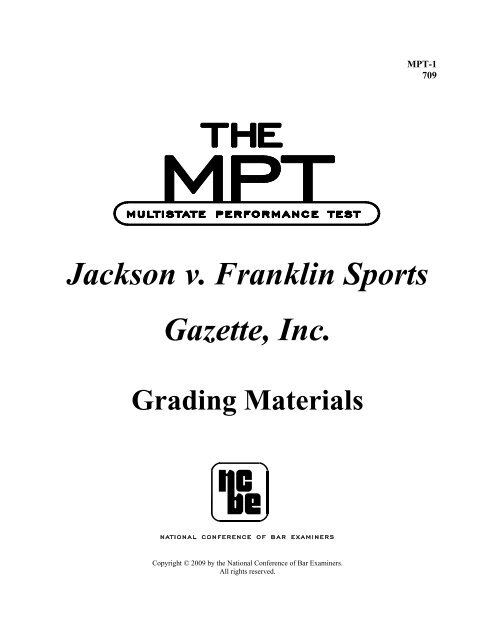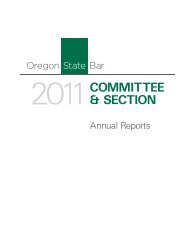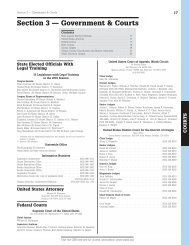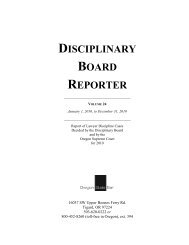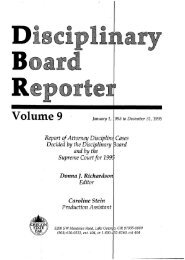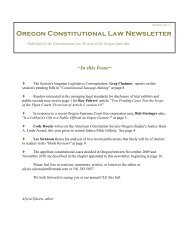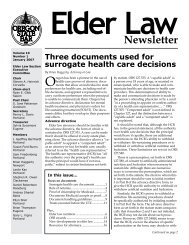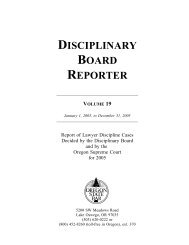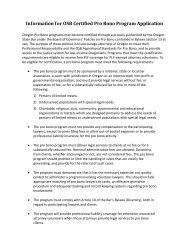Jackson v. Franklin Sports Gazette, Inc. Grading ... - Oregon State Bar
Jackson v. Franklin Sports Gazette, Inc. Grading ... - Oregon State Bar
Jackson v. Franklin Sports Gazette, Inc. Grading ... - Oregon State Bar
Create successful ePaper yourself
Turn your PDF publications into a flip-book with our unique Google optimized e-Paper software.
MPT-1<br />
709<br />
<strong>Jackson</strong> v. <strong>Franklin</strong> <strong>Sports</strong><br />
<strong>Gazette</strong>, <strong>Inc</strong>.<br />
<strong>Grading</strong> Materials<br />
Copyright © 2009 by the National Conference of <strong>Bar</strong> Examiners.<br />
All rights reserved.
The MPT point sheet, grading summary, and grading guidelines describe the factual and legal points<br />
encompassed within the lawyering task to be completed. They outline all the possible issues and points<br />
that might be addressed by an applicant. They are provided to the user jurisdictions for the sole purpose of<br />
assisting graders in grading the examination by identifying the issues and suggesting the resolution of the<br />
problem contemplated by the drafters. These are not official grading guides. Applicants can receive a<br />
range of passing grades, including excellent grades, without covering all the points discussed in these<br />
guides. The model answer is included as an illustration of a thorough and detailed response to the task,<br />
one that addresses all the legal and factual issues the drafters intended to raise in the problem. It is<br />
intended to serve only as an example. Applicants need not present their responses in the same way to<br />
receive good grades. User jurisdictions are free to modify these grading materials, including the suggested<br />
weights assigned to particular points. <strong>Grading</strong> the MPT is the exclusive responsibility of the jurisdiction<br />
using the MPT as part of its admissions process.
Point Sheet
<strong>Jackson</strong> v. <strong>Franklin</strong> <strong>Sports</strong> <strong>Gazette</strong>, <strong>Inc</strong>.<br />
DRAFTERS’ POINT SHEET<br />
In this performance test item, applicants’ law firm represents the <strong>Franklin</strong> <strong>Sports</strong> <strong>Gazette</strong>,<br />
a weekly tabloid sports newspaper. The <strong>Gazette</strong> has been sued by Richard “Action” <strong>Jackson</strong>, star<br />
third baseman of the <strong>Franklin</strong> Blue Sox, <strong>Franklin</strong> City’s major league baseball team, for violation<br />
of his right of publicity under the recently enacted <strong>Franklin</strong> right of publicity statute.<br />
The <strong>Gazette</strong> had, five years earlier, run a photograph of <strong>Jackson</strong> sliding into home plate<br />
(“the Photo”) as part of its coverage of a Blue Sox game. In the Photo, <strong>Jackson</strong>’s back was to the<br />
camera, his face and most of his body were obscured, and only the last digit of his uniform<br />
number was visible.<br />
On June 15, 2009, the <strong>Gazette</strong>’s vice president of marketing sent a memo to its managing<br />
editor suggesting that the <strong>Gazette</strong> run a new advertisement in the <strong>Franklin</strong> City Journal, a daily<br />
newspaper, soliciting subscriptions. The advertisement showed the Photo over the headline<br />
“GET IN WITH THE ACTION!” and text that referred to the <strong>Gazette</strong>’s coverage as including<br />
“award-winning photos like this that put you right in the middle of the action!!!” After the<br />
advertisement ran in the paper as drafted, <strong>Jackson</strong> sued the <strong>Gazette</strong>.<br />
The <strong>Gazette</strong> seeks the law firm’s assistance in defending against the suit. Applicants’ task<br />
is to draft an objective memorandum analyzing whether there is a cause of action under<br />
<strong>Franklin</strong>’s right of publicity statute, identifying the <strong>Gazette</strong>’s possible legal arguments to oppose<br />
such a cause of action, and assessing the likelihood of success.<br />
The File contains 1) the instructional memorandum, 2) a memorandum from the partner<br />
summarizing background research and interviews with the <strong>Gazette</strong>’s managing editor and vice<br />
president of marketing, 3) the memorandum from the vice president of marketing to the<br />
managing editor suggesting the advertisement, and 4) the advertisement itself. The Library<br />
contains 1) the <strong>Franklin</strong> right of publicity statute, 2) excerpts from its legislative history, and 3)<br />
three cases bearing on the subject.<br />
The following discussion covers all the points the drafters intended to raise in the<br />
problem. Applicants need not cover them all to receive passing or even excellent grades. <strong>Grading</strong><br />
is entirely within the discretion of the user jurisdictions.<br />
1
I. FORMAT AND OVERVIEW<br />
The assignment is to prepare a memorandum analyzing whether there is a cause of action<br />
under the recently enacted <strong>Franklin</strong> right of publicity statute. The analysis should be objective,<br />
noting the arguments on both sides of the issues presented and assessing the likelihood of<br />
success on each issue.<br />
<strong>Jackson</strong> v. <strong>Franklin</strong> <strong>Sports</strong> <strong>Gazette</strong>, <strong>Inc</strong>., then poses two specific questions and one<br />
overarching legal issue for applicants:<br />
1) Was <strong>Jackson</strong> identifiable in the Photo? If not, there is no possibility he could<br />
prove facts supporting one of the necessary conditions for a cause of action for<br />
violation of his right of publicity—the requirement that the individual’s persona<br />
be used.<br />
2) Even if he was identifiable in the Photo, is the use of the Photo by the <strong>Gazette</strong><br />
excused under the statute’s exemption for news reporting?<br />
3) The answers to these questions must be informed by the degree to which the prior<br />
common law decisions are relevant and precedential under <strong>Franklin</strong>’s new right of<br />
publicity statute.<br />
No introduction or formal statement of facts is necessary, but applicants should<br />
incorporate the relevant facts into their analyses, using descriptive headings to separate the<br />
issues; those headings presented below are illustrative examples only, and not prescribed<br />
headings that applicants must use.<br />
Applicants would likely review the elements of a cause of action under the right of<br />
publicity statute: 1) use of the plaintiff’s persona, 2) appropriation of the persona for commercial<br />
or other advantage, 3) lack of consent, and 4) resulting injury. With respect to the second<br />
element, there is no doubt that the <strong>Gazette</strong> used the Photo for its commercial advantage.<br />
Likewise, elements 3 and 4 are not in dispute. The key issue is whether the first element has<br />
been met.<br />
It is expected that applicants will conclude that there is a good, although not absolutely<br />
certain, argument that <strong>Jackson</strong> is not identifiable in the Photo. Thus, it is not possible to prove<br />
facts which meet the statutory requirement of identifiability necessary for a cause of action. On<br />
this issue, there is a strong argument that the existing common law precedents supporting the<br />
2
<strong>Gazette</strong>’s position remain good law, notwithstanding the preemption provision of the statute, as<br />
the decisions comport with the statute and its legislative history. In addition, there is a weaker,<br />
but plausible, argument that the use of the Photo comes within the news reporting exception of<br />
the statute. On this issue, the argument that the common law precedents remain good law, while<br />
plausible, is weak, given the language of the statute and legislative history.<br />
II. DISCUSSION<br />
A. Was <strong>Jackson</strong> identifiable?<br />
The statute requires that the individual depicted in a photograph be “readily identifiable.”<br />
§ 62(b). It defines that term as meaning that a viewer can “reasonably determine that the person<br />
depicted in the photograph is the same person who is complaining of its unauthorized use.”<br />
§ 62(b)(1). Applicants should note that the common law right of publicity required that the<br />
plaintiff’s persona be appropriated and argue that this is a standard similar to the standard in the<br />
statute. The legislative history of the statute indicates that prior common law decisions that<br />
accord with the new statutory provisions remain good precedent. This would indicate that the<br />
prior common law decisions on identifiability—Holt v. JuicyCo, <strong>Inc</strong>., and Janig, <strong>Inc</strong>., and Brant<br />
v. <strong>Franklin</strong> Diamond Exchange—are still good law, as each appears to apply the equivalent of<br />
the new statutory standard, albeit not in so many words.<br />
What features or attributes make an individual “identifiable”?<br />
<strong>Jackson</strong>’s face and most of his body are not visible in the Photo. Applicants should note<br />
that Holt teaches that facial representation is not necessary—there, the distinctive and unique<br />
garb of the athlete was sufficient to identify him in the minds of the public. On the other hand,<br />
Brant teaches that such “secondary” identification can only go so far—when an individual is<br />
depicted without any distinctive identifying features whatsoever, the right of publicity is not<br />
violated, for the public cannot identify the individual depicted as the individual making the<br />
claim. Accordingly, applicants must analyze whether <strong>Jackson</strong> is “identifiable” from any nonfacial<br />
features in the Photo, such that a viewer could, in the words of the statute, “reasonably<br />
determine” that it is <strong>Jackson</strong> being depicted in the Photo.<br />
Is <strong>Jackson</strong> “identifiable” from any non-facial features in the Photo?<br />
Applicants should address the question whether there is any aspect of <strong>Jackson</strong>’s depiction<br />
in the Photo that would allow the public to know that it is he, and not another player, being<br />
depicted. Applicants should state that a successful motion to dismiss requires that <strong>Jackson</strong> is not<br />
3
identifiable from the Photo. Applicants should apply the following analysis in concluding that<br />
<strong>Jackson</strong>’s claim is unlikely to succeed:<br />
No part of <strong>Jackson</strong>’s face or body can be identified.<br />
One possible identification that could be made is based on <strong>Jackson</strong>’s uniform. But the<br />
uniform design has not changed in 25 years, and, by definition, a “uniform” is uniform—<br />
it is the same for all players on the team. Thus, the Photo could depict any player on the<br />
team. Applicants should support this analysis by referring to and analogizing with the use<br />
of a common swimsuit design by all competitors in Brant.<br />
Applicants should distinguish Holt by noting that the plaintiff there was “identifiable” by<br />
the unique aspects of his clothing (his gold racing suit), and argue that no similarly<br />
unique attributes are present here.<br />
Another possible identification that could be made is based on the partial visibility of<br />
<strong>Jackson</strong>’s uniform number—the last zero in his double-zero number. But, at the time the<br />
Photo was taken, three other Blue Sox players had numbers ending in zero, and, at the<br />
time of the lawsuit, five other players did. Hence, the picture could have been of any one<br />
of four to six different individuals.<br />
The uniform number analysis requires further refinement—as parts of <strong>Jackson</strong>’s<br />
unclothed body (one arm, his neck) are visible in the Photo, were those teammates whose<br />
numbers ended in zero of the same ethnic background as <strong>Jackson</strong>? As <strong>Jackson</strong> is<br />
Caucasian, if all the other teammates whose numbers ended in zero were non-Caucasian,<br />
that might be enough to find <strong>Jackson</strong> identifiable in the Photo. But the facts tell us that a<br />
sufficient number were also Caucasian (two of the three when the Photo was taken, and<br />
all five at the time of the lawsuit) as to preclude the possibility that <strong>Jackson</strong> could be<br />
reasonably identifiable in the Photo.<br />
Is <strong>Jackson</strong> “identifiable” from the text of the advertisement?<br />
Applicants may note that <strong>Jackson</strong> may argue that the text of the advertisement, by its<br />
repeated use of the word “action,” identifies the individual in the Photo as <strong>Jackson</strong> by<br />
using his nickname. This, it could be argued, is a secondary identifying feature like the<br />
distinctive outfit worn by the plaintiff in Holt. In response, applicants might observe that<br />
the statute’s definition of what makes a person identifiable in a photograph is based<br />
4
solely on visual elements in the photograph itself. Hence, the use of “action” in the text<br />
does not affect the identifiability of the individual depicted in the Photo.<br />
Applicants might also note that <strong>Jackson</strong> could argue that the repeated use of the word<br />
“action” in the text of the advertisement and the reference to him in the memorandum<br />
from Sandi Allen to Jerry Webster show an intent to identify <strong>Jackson</strong> as the individual in<br />
the photograph, and therefore violate his right of publicity. The counterargument would<br />
be that use of “action” in the ad and the memo (with one exception, discussed below) was<br />
as a common noun, not the proper noun of <strong>Jackson</strong>’s nickname: 1) if the headline in the<br />
ad had referred to <strong>Jackson</strong>, it would have said, “GET IN WITH ACTION,” not “GET IN<br />
WITH THE ACTION” (emphasis added); 2) the memo referred to the Photo conveying<br />
“excitement, action, and the kind of sports coverage we stand for” (emphasis added),<br />
using the common noun “action” (with no initial capital letter) rather than the proper<br />
noun (with an initial capital letter); and 3) the text of the ad, referring to “put[ting] you<br />
right in the middle of the action” (emphasis added), also used the common noun, not<br />
<strong>Jackson</strong>’s nickname. Hence, applicants could conclude that the public would understand<br />
the use in the ad in the sense of the common noun “action,” and not as identifying<br />
<strong>Jackson</strong> himself.<br />
Finally, perceptive applicants will note that the memo’s identification of the individual in<br />
the Photo as Action <strong>Jackson</strong> simply indicates the <strong>Gazette</strong>’s knowledge that the Photo<br />
depicts <strong>Jackson</strong> and not another player, and does not go to the question of the<br />
identifiability by the public of <strong>Jackson</strong> in the ad. Although the statute imposes liability on<br />
one who “knowingly uses” an individual’s persona, a second requirement is that the<br />
individual be identifiable. As the court stated in Brant, that knowledge, and even its<br />
admission, does not make the individual “identifiable” by the public in the use itself.<br />
In sum, applicants should conclude that there is a good argument, albeit not a certainty,<br />
that, under the statute and relevant and still-valid precedent, <strong>Jackson</strong> is not identifiable in the<br />
Photo and, as a result, he does not have a cause of action for violation of his right of publicity.<br />
B. Was the use for news reporting?<br />
Applicants should proceed in their analysis to note that, even if <strong>Jackson</strong> were<br />
“identifiable” in the Photo, the use could still be exempt because of the affirmative defense for<br />
5
“news reporting” in the statute, § 62(d). As there seems to be prior common law precedent which<br />
would exempt the <strong>Gazette</strong>’s use in the subscription solicitation, applicants should first address<br />
whether the statute has changed the common law standard; if it has, the prior supporting case law<br />
no longer serves as precedent.<br />
Did the statute change the common law standard of what constitutes news<br />
reporting?<br />
Both the common law right and the new statutory right contain an exception for news<br />
reporting. See § 62(d); Miller v. FSM Enterprises, <strong>Inc</strong>. (Fr. Ct. App. 1988). As the common law<br />
developed, to be exempt the use had to be somehow related to news dissemination:<br />
<br />
In Jancovic v. <strong>Franklin</strong> City Journal, <strong>Inc</strong>. (discussed in Miller), a news photograph that<br />
was reproduced as a poster and sold as such by the newspaper, but without any<br />
reference to its news function, was held to violate the individual’s common law right of<br />
publicity. The court held that it made no difference that the poster came from a news<br />
organization, as the lack of reference to the organization or its news activities removed<br />
the use from the exemption.<br />
<br />
Applicants should distinguish Jancovic on the grounds that the <strong>Gazette</strong>’s use did indeed<br />
refer to its news reporting activities. The text of the advertisement made direct reference<br />
to the activities and type of news coverage the <strong>Gazette</strong> provides (“great stories,”<br />
“coverage of every <strong>Franklin</strong> team,” “award-winning photos”).<br />
<br />
Applicants will also note that a common law precedent, Miller, supports exemption for<br />
exactly the sort of use made here by the <strong>Gazette</strong>. In Miller, a magazine used a news<br />
photograph for a subscription solicitation, much like the use here. The court held (over<br />
dissent) that the relation of the photograph to the news function of the magazine was<br />
sufficient to qualify for the exemption, as the use was an example of the magazine’s<br />
news coverage.<br />
<br />
Is Miller still good law under the statute? The statute grants an affirmative defense for<br />
use “in connection with any news, public affairs, or sports broadcast or account”<br />
6
(emphasis added). While this obviously applies to stories and news accounts, it is<br />
unclear as to whether it would extend to solicitations for subscriptions as was the case in<br />
Miller—could the solicitation, which illustrates the type of “news or sports accounts”<br />
the publication covers, itself be described as a “news . . . or sports . . . account”?<br />
Arguing against applying the Miller common law precedent is the plain language of the<br />
statute, which refers only to “account[s]” (in contrast, in Miller, the court was not<br />
construing statutory language but analyzing the issue in the context of whether the use<br />
of the plaintiff’s image fell within the term “news reporting” under the common law).<br />
The legislative history could also be seen as, at best, ambiguous: 1) it notes that there<br />
was “uncertainty” as to whether uses “ancillary” to news reporting incurred liability,<br />
and 2) it emphasizes the “broadcast or account” language of the new statute. Hence,<br />
applicants should note the potential argument that the subscription solicitation furthers<br />
the goal of supporting news reporting by making the public aware of the <strong>Gazette</strong>’s<br />
coverage of issues of public interest, and thus the Miller rationale should be followed as<br />
good precedent, while also noting the weakness of the argument.<br />
<br />
The case for a valid affirmative defense could be seen as a toss-up at best. The statute<br />
speaks of the use of a photograph “in connection with any . . . sports broadcast or<br />
account.” Is this language sufficiently broad to cover the advertisement? Is the term so<br />
ambiguous as to make resort to the legislative history necessary? Perceptive applicants<br />
will state that, while one could argue that the use of the Photo in the solicitation as an<br />
example of the <strong>Gazette</strong>’s content was intended to make the public aware of the<br />
<strong>Gazette</strong>’s coverage, one might just as easily argue that the statutory language is clear<br />
and includes only “account[s]” and not advertisements for the news medium itself.<br />
If the statute adopted the common law standard for affirmative defense as set forth<br />
in Miller, did the <strong>Gazette</strong>’s specific use of the Photo meet that standard?<br />
<br />
Applicants should also note that the Miller precedent itself is not clear-cut and does not<br />
necessarily favor the <strong>Gazette</strong>. The Miller court opined that, if the use could be seen as<br />
an implied endorsement of the commercial purpose of the magazine, then the relation of<br />
the subscription solicitation to the news aspects would disappear and the use would<br />
7
violate the individual’s right of publicity. The court gave as an example of such an<br />
impermissible implied endorsement the use of the individual’s name in the text of the<br />
solicitation.<br />
<br />
The <strong>Gazette</strong>’s advertisement did use <strong>Jackson</strong>’s nickname (“Action”) in both its headline<br />
and text, but, it could be argued, not as referring to the individual but rather to the<br />
common usage of the word “action,” as previously noted. Hence, it could be argued, the<br />
use of the word would not be seen as an endorsement by <strong>Jackson</strong>. Again, applicants<br />
should note that the facts are ambiguous and this point could go against the <strong>Gazette</strong>.<br />
<br />
Perceptive applicants might conclude that the question could ultimately be whether it is<br />
the <strong>Gazette</strong>’s intent or the public’s perception that determines the answer to whether an<br />
endorsement was implied.<br />
Applicants should conclude that, while there is an argument to be made that <strong>Jackson</strong>’s<br />
claim is not viable because the subscription solicitation falls within the statute’s affirmative<br />
defense for “news reporting,” that result is not certain, and good arguments could be made the<br />
other way that could defeat reliance on the “news reporting” affirmative defense.<br />
8
<strong>Grading</strong> Summary<br />
and<br />
<strong>Grading</strong> Guidelines
Multistate Performance Test<br />
GRADING SUMMARY<br />
<strong>Jackson</strong> v. <strong>Franklin</strong> <strong>Sports</strong> <strong>Gazette</strong>, <strong>Inc</strong>.<br />
The <strong>Franklin</strong> <strong>Sports</strong> <strong>Gazette</strong> has been sued by baseball star Richard “Action” <strong>Jackson</strong> for allegedly<br />
violating his right of publicity. Applicants must draft a memo analyzing whether <strong>Jackson</strong> has a cause of<br />
action (COA) under <strong>Franklin</strong>’s right of publicity statute and whether the <strong>Gazette</strong> has any arguments to<br />
oppose that COA. Applicants should conclude that <strong>Jackson</strong> is not identifiable in the Photo, and that the<br />
<strong>Gazette</strong>’s use of the Photo could fall within the statute’s news reporting exemption.<br />
Whether <strong>Jackson</strong> Has a COA under <strong>Franklin</strong>’s New Right of Publicity Statute (60% total weight)<br />
A COA under the statute requires 1) use of the plaintiff’s persona, 2) appropriation of the persona for<br />
commercial or other advantage, 3) lack of consent, and 4) resulting injury.<br />
The key issue is use of <strong>Jackson</strong>’s persona. Presumably, commercial advantage, lack of consent,<br />
and injury will be easily established.<br />
Cases on the common law COA for appropriation of persona remain good law. (10% weight)<br />
The individual’s face need not be visible; distinctive clothing or other features may be<br />
enough for identification. Holt; Brant.<br />
Under § 62(b), <strong>Jackson</strong> is not “readily identifiable” in the Photo by the public. (30% weight)<br />
No part of his face or body can be identified.<br />
His clothing does not identify him—the second “0” on his uniform is visible, but four players<br />
had numbers ending in “0” that season, and six players now wear such numbers.<br />
<strong>Jackson</strong> is Caucasian, as are the other five players who wear numbers ending in “0”; when<br />
the Photo was taken, two other Caucasian players had numbers ending in “0.”<br />
The word “action,” <strong>Jackson</strong>’s nickname, in the ad is not sufficient to identify him. (20% weight)<br />
It is arguable that identifiability must be established by the Photo alone, without the ad’s text.<br />
This construction would favor the <strong>Gazette</strong>.<br />
The better argument is that here, “action” is a common noun, not a proper noun (e.g., “Get in<br />
with Action”), and thus there is no connection with Action <strong>Jackson</strong>.<br />
In sum, it is likely that <strong>Jackson</strong> is not identifiable and his complaint thus fails to state a COA.<br />
Whether the <strong>Gazette</strong>’s use of the Photo constitutes news reporting under § 62(d) (40% total weight)<br />
Miller, which predates § 62, permitted use of a news photo in a subscription ad as an ancillary<br />
use illustrating the magazine’s news coverage.<br />
The <strong>Gazette</strong>’s use of the Photo would likely be a permitted use under Miller.<br />
But <strong>Jackson</strong> could make a plausible argument that the use of his likeness and the word<br />
“action” could be deemed an endorsement by <strong>Jackson</strong> of the <strong>Gazette</strong>—not a permitted use.<br />
This is a closer case than Miller, where the plaintiff’s name was not cited in the ad.<br />
The language of § 62(d) creates uncertainty regarding ancillary uses. Is Miller still good law?<br />
§ 62(d) refers only to a news “account,” thus, a court could conclude that it is not as broad as<br />
the common law “news reporting” defense.<br />
However, § 62(d)’s reference to a use “in connection with any news … account” may lend<br />
support for uses which advertise the news medium itself.<br />
Applicants may come down either way on this issue—the point is that they recognize and<br />
grapple with the ambiguity in the statutory language. 20% weight should be allocated to the issue<br />
of whether Miller remains good law and the other 20% to the application of the law to the facts.<br />
11<br />
Not for Public Distribution
Multistate Performance Test<br />
<strong>Jackson</strong> v. <strong>Franklin</strong> <strong>Sports</strong> <strong>Gazette</strong>, <strong>Inc</strong>.<br />
<strong>Grading</strong> Guidelines<br />
I. Overview <strong>Grading</strong> Comments<br />
Applicants’ law firm represents the <strong>Franklin</strong> <strong>Sports</strong> This section is informative only<br />
<strong>Gazette</strong>, a tabloid newspaper that has been sued by Richard and no grading weight is<br />
“Action” <strong>Jackson</strong>, a star baseball player, for violation of assigned.<br />
his right of publicity after the <strong>Gazette</strong> used a photo of<br />
<strong>Jackson</strong> sliding into home plate (the “Photo”) in an<br />
advertisement soliciting subscriptions to the <strong>Gazette</strong>.<br />
<br />
<br />
<br />
<br />
<br />
Years ago, the <strong>Gazette</strong> had run the Photo as part of its<br />
coverage of a Blue Sox baseball game. In the Photo,<br />
<strong>Jackson</strong>’s back is to the camera, his face and most of his<br />
body are obscured, and only the last digit of his uniform<br />
number, 00, is visible.<br />
In June 2009, the <strong>Gazette</strong> approved a new advertisement to<br />
solicit subscriptions. The advertisement showed the Photo<br />
over the headline “GET IN WITH THE ACTION!” and<br />
text that referred to the <strong>Gazette</strong>’s coverage as including<br />
“award-winning photos like this that put you right in the<br />
middle of the action!!!”<br />
After the advertisement ran, <strong>Jackson</strong>, who earns millions of<br />
dollars from licensing his name and image, sued the<br />
<strong>Gazette</strong>, claiming that the advertisement infringed on his<br />
right of publicity and that he was damaged by the loss of<br />
the license fee he would have gained from the use of his<br />
image and the loss of his ability to license the use of his<br />
image to other sports publications.<br />
Applicants’ task is to analyze the merits of <strong>Jackson</strong>’s cause<br />
of action in light of <strong>Franklin</strong>’s recently enacted right of<br />
publicity statute, § 62, and the relevant cases, all of which<br />
predate the statute.<br />
Applicants should conclude the <strong>Gazette</strong> can pose strong<br />
arguments against <strong>Jackson</strong>’s COA. The merits of the<br />
affirmative defense for “news reporting” are less certain.<br />
No discrete weight is assigned to<br />
the “format” component of the<br />
task, nor are applicants given a<br />
specific template to follow in<br />
drafting their memos. No<br />
separate statement of facts is<br />
required. Applicants should incorporate<br />
the facts in their<br />
analyses and organize their<br />
discussions into sections with<br />
descriptive headings.<br />
Whether or not to weight format<br />
is left to the discretion of the user<br />
jurisdictions.<br />
The assignment is to write an<br />
objective memorandum. Work<br />
product that is persuasive in tone<br />
is not responsive to the<br />
instructions in the call memo.<br />
II. Whether <strong>Jackson</strong> is readily identifiable in the Photo<br />
The elements of a violation of the right of publicity are 1)<br />
use of the plaintiff’s persona, 2) to the defendant’s<br />
commercial or other advantage, 3) without the plaintiff’s<br />
consent, and 4) thereby causing injury to the plaintiff. Fr.<br />
Code § 62; Miller v. FSM Enter., <strong>Inc</strong>. (Fr. Ct. App. 1988).<br />
12<br />
(60% suggested total weight)<br />
The elements of a § 62 claim are<br />
the same as for the common law<br />
right of publicity cause of action.<br />
Not for Public Distribution
Multistate Performance Test<br />
<strong>Jackson</strong> v. <strong>Franklin</strong> <strong>Sports</strong> <strong>Gazette</strong>, <strong>Inc</strong>.<br />
<br />
<br />
These elements appear to be undisputed: <strong>Jackson</strong> will be<br />
able to show that the <strong>Gazette</strong> knowingly used the Photo,<br />
for a commercial purpose (the ad), and that he did not<br />
consent to its use, nor did he receive any fee.<br />
Better answers will note that Holt and Brant predate the<br />
enactment of § 62, but that those cases are still good law<br />
because the definition of identifiability used is in accord<br />
with the statutory standard. See Leg. History.<br />
<strong>Grading</strong> Guidelines<br />
There is no question that <strong>Jackson</strong><br />
did not consent to the use of his<br />
persona, and that he will be able<br />
to show injury—he earns<br />
millions from licensing his name<br />
and likeness.<br />
(10% suggested weight)<br />
<br />
Thus, the dispositive issue is whether the <strong>Gazette</strong> made use<br />
of <strong>Jackson</strong>’s persona. Doing so requires that <strong>Jackson</strong> be<br />
“readily identifiable” in the Photo. See § 62. That is, could<br />
the public “reasonably determine” that the Photo depicts<br />
<strong>Jackson</strong>, and not another Blue Sox player? Id.<br />
(30% suggested weight)<br />
<br />
The award-winning Photo shows <strong>Jackson</strong>, in his team<br />
uniform, sliding into home plate. His back is to the<br />
camera and his face is not visible in the Photo. Only the<br />
second “0” of <strong>Jackson</strong>’s team number, “00”, is visible.<br />
<br />
<br />
Neither the statute nor <strong>Franklin</strong> case law requires that to be<br />
“readily identifiable,” an individual’s face must be visible.<br />
In Holt v. JuicyCo, <strong>Inc</strong>., and Janig, <strong>Inc</strong>., the athlete was<br />
identifiable by virtue of his unique and distinctive racing<br />
suit; thus the advertising company violated Holt’s right of<br />
publicity even though it had digitally removed his race<br />
number from the video.<br />
<br />
Holt is distinguishable: <strong>Jackson</strong> is wearing the team<br />
uniform, and, while his number would usually identify<br />
him, only the last “0” is visible.<br />
<br />
<br />
<br />
Other players, both when the Photo was taken five years<br />
ago and now, have worn numbers ending in “0,” and at<br />
both times, there were Caucasian players other than<br />
<strong>Jackson</strong> wearing team numbers ending in “0.”<br />
Thus, applicants should conclude that, as in Brant, where<br />
only the plaintiff’s legs and a portion of her swimsuit were<br />
visible, <strong>Jackson</strong> is not “readily identifiable.”<br />
The fact that the <strong>Gazette</strong> knew the Photo was of <strong>Jackson</strong><br />
does not speak to the issue of whether <strong>Jackson</strong> is<br />
identifiable.<br />
13<br />
Not for Public Distribution
Multistate Performance Test<br />
<strong>Jackson</strong> v. <strong>Franklin</strong> <strong>Sports</strong> <strong>Gazette</strong>, <strong>Inc</strong>.<br />
<strong>Grading</strong> Guidelines<br />
<br />
The ad’s text (“GET IN WITH THE ACTION”, etc.) lends<br />
support to <strong>Jackson</strong>’s claim, but probably is not enough to<br />
demonstrate that he is readily identifiable.<br />
(20% suggested weight)<br />
<br />
<br />
The <strong>Gazette</strong> could argue that identifiability must be<br />
established by the photo itself, without reference to any<br />
accompanying text—after all, § 62(b) makes no<br />
mention of any text presented with the photograph.<br />
In the ad, “action” is used as a common noun. If the<br />
text were “Get in with Action” (proper noun), <strong>Jackson</strong><br />
would have a much stronger case.<br />
<br />
Because it appears that <strong>Jackson</strong> is not readily identifiable<br />
in the Photo, he cannot maintain a cause of action for<br />
violation of his right of publicity.<br />
III. Whether the <strong>Gazette</strong>’s use of the Photo falls within the right<br />
of publicity statute’s exemption for news reporting<br />
(40% suggested total weight)*<br />
<br />
<br />
<br />
Use of an individual’s photograph for “news reporting” is<br />
an affirmative defense to a claim for violation of the right<br />
of publicity. § 62(d).<br />
But has the statute changed the common law standard for<br />
what is “news reporting” in the context of right of publicity<br />
actions?<br />
The common law: Miller v. FSM Enter., <strong>Inc</strong>. (Fr. Ct. App.<br />
1988) discussed the common law exemption to the right of<br />
publicity for news reporting, holding that the use of the<br />
plaintiff’s image “informed the public as to the nature and<br />
quality of [the magazine’s] news reporting.” Although the<br />
photo was used to solicit subscriptions, the court held that<br />
the exemption for news reporting extended to “incidental<br />
advertising of the news medium itself.”<br />
<br />
The <strong>Gazette</strong>’s advertisement explicitly references its<br />
news coverage of sporting events (“Great stories!<br />
Coverage of every <strong>Franklin</strong> team!!”).<br />
However an applicant resolves<br />
the “readily identifiable” issue,<br />
he or she should go on to discuss<br />
the application of the news<br />
reporting affirmative defense.<br />
Applicants should recognize that<br />
the statutory language varies<br />
from the common law’s “news<br />
reporting” exception.<br />
*Roughly 20% weight is<br />
suggested for that portion of<br />
applicants’ answers that grapple<br />
with whether Miller is still good<br />
law. The remaining 20% credit is<br />
allocated for their application of<br />
the law to the facts.<br />
<br />
Thus, as in Miller, the use here can be distinguished<br />
from that in Jancovic, where the infringing use of the<br />
plaintiff’s image in a poster had no connection to news<br />
reporting, even though it was a newspaper that created<br />
the poster and profited from its sale.<br />
14<br />
Not for Public Distribution
Multistate Performance Test<br />
<strong>Jackson</strong> v. <strong>Franklin</strong> <strong>Sports</strong> <strong>Gazette</strong>, <strong>Inc</strong>.<br />
<strong>Grading</strong> Guidelines<br />
<br />
<br />
Miller limited the news reporting exemption to cases<br />
where “there can be no inference of endorsement by the<br />
individual depicted.” In dictum, the court speculated<br />
that if the ad had featured the plaintiff’s name, that<br />
might constitute an implied endorsement and the<br />
exemption would not apply.<br />
Citing Miller, <strong>Jackson</strong> could claim that the <strong>Gazette</strong>’s<br />
use of the Photo, coupled with the repeated use of the<br />
word “action” in the ad, constituted an “implied<br />
endorsement” by <strong>Jackson</strong> and was meant to exploit his<br />
popularity as “Action <strong>Jackson</strong>.”<br />
<br />
<br />
<br />
<br />
The statute: Citing § 62, <strong>Jackson</strong> could successfully argue<br />
that by using the phrase “sports broadcast or account” the<br />
legislature limited the affirmative defense to “accounts”<br />
and that it does not cover ancillary uses such as<br />
advertisements.<br />
On the other hand, the legislative history for § 62 suggests<br />
it is an open question whether the affirmative defense for<br />
the use of a photograph “in connection with any news . . .<br />
or sports broadcast or account” encompasses ancillary<br />
uses, such as the <strong>Gazette</strong>’s use of the Photo.<br />
If Miller remains good law, the <strong>Gazette</strong>’s use of the Photo<br />
likely comes within the news reporting affirmative defense<br />
and does not infringe <strong>Jackson</strong>’s right of publicity.<br />
In sum, the issue can be argued either way, although it<br />
appears somewhat more likely that a court would be<br />
inclined to follow Miller and conclude that the right of<br />
publicity is not infringed by ancillary use in advertising the<br />
news medium itself.<br />
This is a subtle issue, and could<br />
go either way. Thus applicants<br />
should receive full credit for<br />
identifying and thoroughly<br />
analyzing this issue, regardless of<br />
their ultimate conclusions.<br />
15<br />
Not for Public Distribution
Model Answer
Multistate Performance Test<br />
<strong>Jackson</strong> v. <strong>Franklin</strong> <strong>Sports</strong> <strong>Gazette</strong>, <strong>Inc</strong>.<br />
Model Answer<br />
MEMORANDUM<br />
TO: Robert Benson<br />
FROM: Applicant<br />
RE: <strong>Jackson</strong> v. <strong>Franklin</strong> <strong>Sports</strong> <strong>Gazette</strong>, <strong>Inc</strong>.<br />
DATE: July 28, 2009<br />
You have asked me to analyze whether Richard “Action” <strong>Jackson</strong> has a cause of action<br />
under <strong>Franklin</strong>’s right of publicity statute and the legal arguments for opposing such a cause of<br />
action. As discussed below, it is likely that <strong>Jackson</strong> cannot maintain a cause of action.<br />
Whether <strong>Jackson</strong> Has a Cause of Action Under the Right of Publicity Statute<br />
<strong>Jackson</strong>’s claim arises from the <strong>Gazette</strong>’s use of a photo of him sliding into home plate<br />
(“the Photo”). <strong>Franklin</strong>’s newly enacted right of publicity statute, § 62(a), provides: “Any person<br />
who knowingly uses another’s … photograph, or likeness, in any manner … for purposes of<br />
advertising or selling, or soliciting purchases of products, … without such person’s prior consent,<br />
… shall be liable for any damages sustained by the person … injured as a result thereof.” A<br />
cause of action under the statute (which codifies the common law standard for violation of the<br />
right of publicity) has four elements: (1) the defendant’s knowing use of the plaintiff’s persona,<br />
(2) appropriation of the plaintiff’s persona to the defendant’s commercial or other advantage, (3)<br />
lack of consent, and (4) resulting injury. Miller v. FSM Enter., <strong>Inc</strong>. (Fr. Ct. App. 1988).<br />
As to the first element, the <strong>Gazette</strong> knowingly used a photo of <strong>Jackson</strong> in its<br />
advertisement. In her memorandum, Sandi Allen, the <strong>Gazette</strong>’s vice president of marketing,<br />
notes that the Photo is of “Action” <strong>Jackson</strong> and that it “conveys excitement, action, and the kind<br />
of sports coverage we stand for.” With regard to the second element, the <strong>Gazette</strong> used the Photo<br />
for its commercial advantage; the Photo was the focus of the <strong>Gazette</strong>’s advertisement in the<br />
<strong>Franklin</strong> City Journal to solicit subscriptions. Indeed, it seems that using the Photo had the<br />
desired effect: the week after the advertisement ran, new <strong>Gazette</strong> subscriptions in response to the<br />
advertisement (shown by use of the coupon) increased by 18%. Third, <strong>Jackson</strong> never consented<br />
to the <strong>Gazette</strong>’s use of the Photo, nor does it appear that the <strong>Gazette</strong> sought to obtain his consent<br />
at any time. Finally, it is presumed that <strong>Jackson</strong> will be able to show the requisite injury because<br />
the <strong>Gazette</strong> did not pay him for use of his image and <strong>Jackson</strong> has earned millions of dollars by<br />
licensing the use of his name and likeness. In reviewing a motion to dismiss, the court would<br />
accept as true <strong>Jackson</strong>’s allegation that the <strong>Gazette</strong> has damaged him by depriving him of a<br />
17<br />
Not for Public Distribution
Multistate Performance Test<br />
Model Answer<br />
<strong>Jackson</strong> v. <strong>Franklin</strong> <strong>Sports</strong> <strong>Gazette</strong>, <strong>Inc</strong>.<br />
license fee for this use of his image and of his ability to license the use of his image to other<br />
sports publications.<br />
It is not enough for a claim under § 62 that the <strong>Gazette</strong> and <strong>Jackson</strong> know that he is the<br />
player sliding into home plate in the Photo. <strong>Jackson</strong> must be “readily identifiable” in the Photo.<br />
A plaintiff is “readily identifiable” when “one who views the photograph with the naked eye can<br />
reasonably determine that the person depicted in the photograph is the same person who is<br />
complaining of its unauthorized use.” § 62(b)(1).<br />
Here, the Photo shows <strong>Jackson</strong>’s back as he slid with one arm thrown up in the air. Dirt<br />
from the slide obscures most of <strong>Jackson</strong>’s body and uniform number and only the second zero of<br />
his “00” number is partially visible. <strong>Jackson</strong>’s face cannot be seen. The <strong>Franklin</strong> Blue Sox do not<br />
have the player’s name on the back of the team uniform, and the uniform design has remained<br />
the same for the last 25 years. During that time, the Blue Sox have had as many as five other<br />
players wearing numbers ending in “0” and who are also Caucasian, as is <strong>Jackson</strong>.<br />
Although the right of publicity statute preempts the common law cause of action for<br />
violations of that right, case law that is in accord with the statutory provisions “continue[s] to<br />
constitute good precedent.” Leg. History. Thus, Holt v. JuicyCo, <strong>Inc</strong>., and Janig, <strong>Inc</strong>. (Fr. Sup.<br />
Ct. 2001) remains good law, because in determining whether the plaintiff stated a cause of action<br />
under the common law right of publicity, the court considered whether he was “identifiable”<br />
from the use made of his image. This standard is not inconsistent with the § 62 requirement that<br />
a plaintiff be “readily identifiable.”<br />
In Holt, the plaintiff, a famous downhill skier, sued when videotape of one of his races<br />
was used in a TV commercial. Even though Holt’s face, name, bib number, and sponsor’s<br />
patches were not visible, the court held that he was identifiable for purposes of a cause of action<br />
given “the distinctive appearance of Holt’s suit and its potential, as a factual matter, to allow the<br />
public to identify Holt as the skier in the commercial.” Because the racing suit’s color and design<br />
were unique to Holt, a trier of fact could reasonably conclude that it was Holt, and not another<br />
skier, who was endorsing the product.<br />
By contrast, in Brant v. <strong>Franklin</strong> Diamond Exchange, Ltd. (Fr. Ct. App. 2003), a<br />
collegiate diving star was not identifiable in a photograph that showed only her legs and the<br />
bottom of her swimsuit as she entered the water after a perfect dive. Because her swimsuit was<br />
identical to the suits worn by all the other divers in the competition and she had no identifying<br />
18<br />
Not for Public Distribution
Multistate Performance Test<br />
Model Answer<br />
<strong>Jackson</strong> v. <strong>Franklin</strong> <strong>Sports</strong> <strong>Gazette</strong>, <strong>Inc</strong>.<br />
scars or other features that could be seen in the photo, nor was there any indication of the venue,<br />
time, or event depicted, the court held that the public could not conclude that the photo was of<br />
Brant “as opposed to any other diver,” thus Brant could not prove facts to support her claim.<br />
The facts here fall on the continuum between the Holt and Brant cases. At most, there is<br />
enough detail in the Photo to show that the player sliding into home plate is one of the Caucasian<br />
Blue Sox players who has worn a number ending in “0” at some point in the last 25 years. But<br />
the Blue Sox currently have a total of six Caucasian players wearing numbers ending in “0.”<br />
Thus, the Photo could be depicting any one of these six players currently on the Blue Sox roster,<br />
or any one of three Caucasian players when the Photo was taken.<br />
The Text Accompanying the Photo Does Not Identify <strong>Jackson</strong>.<br />
While the <strong>Gazette</strong>’s advertisement includes the word “action,” <strong>Jackson</strong>’s nickname, it<br />
probably does not render him readily identifiable in the photograph.<br />
If the statute is strictly construed, it can be argued that only the photograph is to be<br />
considered when determining if an individual is identifiable. A person is readily identifiable<br />
“when one who views the photograph with the naked eye can reasonably determine that the<br />
person depicted in the photograph” is the person asserting the unauthorized use of his or her<br />
image. § 62(b)(1). Viewing the Photo in isolation, it is unlikely that with any confidence a<br />
member of the public could reasonably determine that <strong>Jackson</strong> was the player sliding into home<br />
plate.<br />
However, <strong>Jackson</strong> has a significantly stronger case if the Photo is considered in<br />
conjunction with the text of the advertisement. (Indeed, it would be unduly restrictive to divorce<br />
the Photo from the text.) It can be anticipated that <strong>Jackson</strong> will argue that from the use of the<br />
phrase “Get in with the action,” it is inevitable that the public would conclude that the Photo<br />
depicts <strong>Jackson</strong>, because he is known by the sobriquet “Action <strong>Jackson</strong>.” But such an argument<br />
ignores the fact that the word “action” is used as a common noun in the advertisement. Had the<br />
advertisement featured the exhortation to “Get in with Action,” using “Action” as a proper noun,<br />
a plausible argument could be made that the combination of the Photo and the word “Action”<br />
would readily identify the individual in the Photo as <strong>Jackson</strong>. Furthermore, the word “action” is a<br />
common word to use in conjunction with describing sports coverage by any media outlet. It is<br />
hardly so unusual as to immediately inspire a connection with Richard “Action” <strong>Jackson</strong> rather<br />
than with a word describing the kind of sports coverage offered.<br />
19<br />
Not for Public Distribution
Multistate Performance Test<br />
Model Answer<br />
<strong>Jackson</strong> v. <strong>Franklin</strong> <strong>Sports</strong> <strong>Gazette</strong>, <strong>Inc</strong>.<br />
It appears likely that the court will conclude that <strong>Jackson</strong> is not readily identifiable in the<br />
Photo, and that therefore he cannot establish an appropriation of his persona under § 62.<br />
Even if <strong>Jackson</strong> Is Identifiable, the <strong>Gazette</strong> May Argue That Using the Photo in an<br />
Advertisement Soliciting Subscriptions is Within the Statute’s News Reporting Exemption.<br />
Pursuant to § 62(d), the use of a photograph “in connection with any news, … or sports<br />
broadcast or account … shall not constitute a use for which consent is required.” The issue then<br />
becomes whether the phrase “news, … or sports broadcast or account” encompasses the use of a<br />
plaintiff’s likeness in an advertisement soliciting subscriptions. At common law, this was<br />
referred to as the “exemption for news reporting.” Miller v. FSM Enter., <strong>Inc</strong>. (Fr. Ct. App. 1988).<br />
In Miller, a professional figure skater sued for the use of her photo in an advertisement<br />
soliciting subscriptions to Figure Skating! Magazine (FSM). The advertisement’s text did not<br />
mention her name, but boasted of FSM’s coverage of the sport. FSM argued that the use of the<br />
photo in the advertisement was for newsworthy purposes, and therefore was within the news<br />
reporting exemption to the right of publicity. The court agreed, distinguishing Jancovic v.<br />
<strong>Franklin</strong> City Journal, <strong>Inc</strong>. (Fr. Sup. Ct. 1984), wherein a photo of a hockey player, originally<br />
published in the defendant newspaper, was reprinted as a poster and sold to fans. With no text on<br />
the poster, not even the newspaper’s name, “there could be no relationship in the mind of the<br />
consumer between the poster and the newspaper, and more particularly the news dissemination<br />
function of the newspaper.” Therefore the news reporting exemption did not apply.<br />
In Miller, the court held that the use of the skater’s photograph “was incidental to the<br />
advertising of [the magazine] in relationship to its news reporting function. The use illustrated<br />
the way in which Miller had earlier been properly and fairly depicted by the magazine in a<br />
legitimate news account. It informed the public as to the nature and quality of [the magazine’s]<br />
news reporting.” FSM’s motive for using the photo—advertising and solicitation—did not<br />
determine the issue. Rather, “the common law must accord exempt status to incidental<br />
advertising of the news medium itself.” Nevertheless, the exemption is limited—it can apply<br />
only “when there can be no inference of endorsement by the individual depicted.”<br />
The <strong>Franklin</strong> right of publicity statute codifies the common law as set forth in Miller in<br />
that it also exempts use of an individual’s persona “in connection with any news, … or sports<br />
broadcast or account.” § 62(d). While the <strong>Franklin</strong> legislature did not use the term “news<br />
reporting,” and is silent with regard to ancillary uses of an individual’s photograph or image, it is<br />
20<br />
Not for Public Distribution
Multistate Performance Test<br />
Model Answer<br />
<strong>Jackson</strong> v. <strong>Franklin</strong> <strong>Sports</strong> <strong>Gazette</strong>, <strong>Inc</strong>.<br />
reasonable to assume that the phrase “in connection with … sports broadcast or account” is<br />
broad enough to cover what the Miller court described as “incidental advertising of the news<br />
medium itself.” In addition, it can be assumed that the legislature was aware of the holding in<br />
Miller, and would have included statutory language to exclude ancillary uses of an individual’s<br />
image from the affirmative defense if it had intended the new statute to supersede Miller.<br />
<strong>Jackson</strong> may argue that the <strong>Gazette</strong>’s use of the Photo presents what the dissent in Miller<br />
referred to as an implied endorsement by <strong>Jackson</strong> of the <strong>Gazette</strong>. However, in Miller, the<br />
plaintiff was clearly identifiable in the photo, thus increasing the possibility that the viewing<br />
public could conclude that the plaintiff was endorsing the publication. But again, the majority<br />
rejected that view, concluding that the advertisement’s photo and text did not “tie [the plaintiff]<br />
explicitly to the solicitation for subscriptions.” Likewise, the text in the <strong>Gazette</strong>’s advertisement<br />
which directly refers to the Photo states, “Look at all you get: … award-winning photos like this<br />
that put you right in the middle of the action!!!” The Photo was expressly used to illustrate the<br />
quality of the <strong>Gazette</strong>’s news coverage. If the <strong>Gazette</strong> had wanted to ensure that the public<br />
connected its coverage with <strong>Jackson</strong>, the text could have mentioned “photos of Action <strong>Jackson</strong><br />
and all your favorite Blue Sox players” or otherwise singled him out for notice.<br />
Conclusion<br />
It appears likely that <strong>Jackson</strong>’s complaint against the <strong>Gazette</strong> does not state a cause of<br />
action under the right of publicity statute, <strong>Franklin</strong> Code § 62. To state a claim, <strong>Jackson</strong> must be<br />
readily identifiable in the Photo. While a member of the public could assume that it is <strong>Jackson</strong> in<br />
the Photo, as he may be the player who most readily comes to mind when the Blue Sox are<br />
mentioned, given the number of other Caucasian players who wear or have worn a team number<br />
ending in “0” in the past 25 years, it is unreasonable to conclude that the Photo is of <strong>Jackson</strong>, as<br />
opposed to one of those other players. The use in the advertisement of the word “action” as a<br />
common noun should not alter this result.<br />
Further, if a court were to find that the <strong>Gazette</strong> did use <strong>Jackson</strong>’s image to its benefit<br />
without consent, the facts at hand could come within the affirmative defense for news reporting.<br />
Assuming Miller remains good law, the <strong>Gazette</strong> may make incidental use of <strong>Jackson</strong>’s image in<br />
advertising the newspaper. Nor under Miller do the facts support the conclusion that the use of<br />
the Photo is an implicit endorsement by <strong>Jackson</strong> of the <strong>Gazette</strong>.<br />
21<br />
Not for Public Distribution


